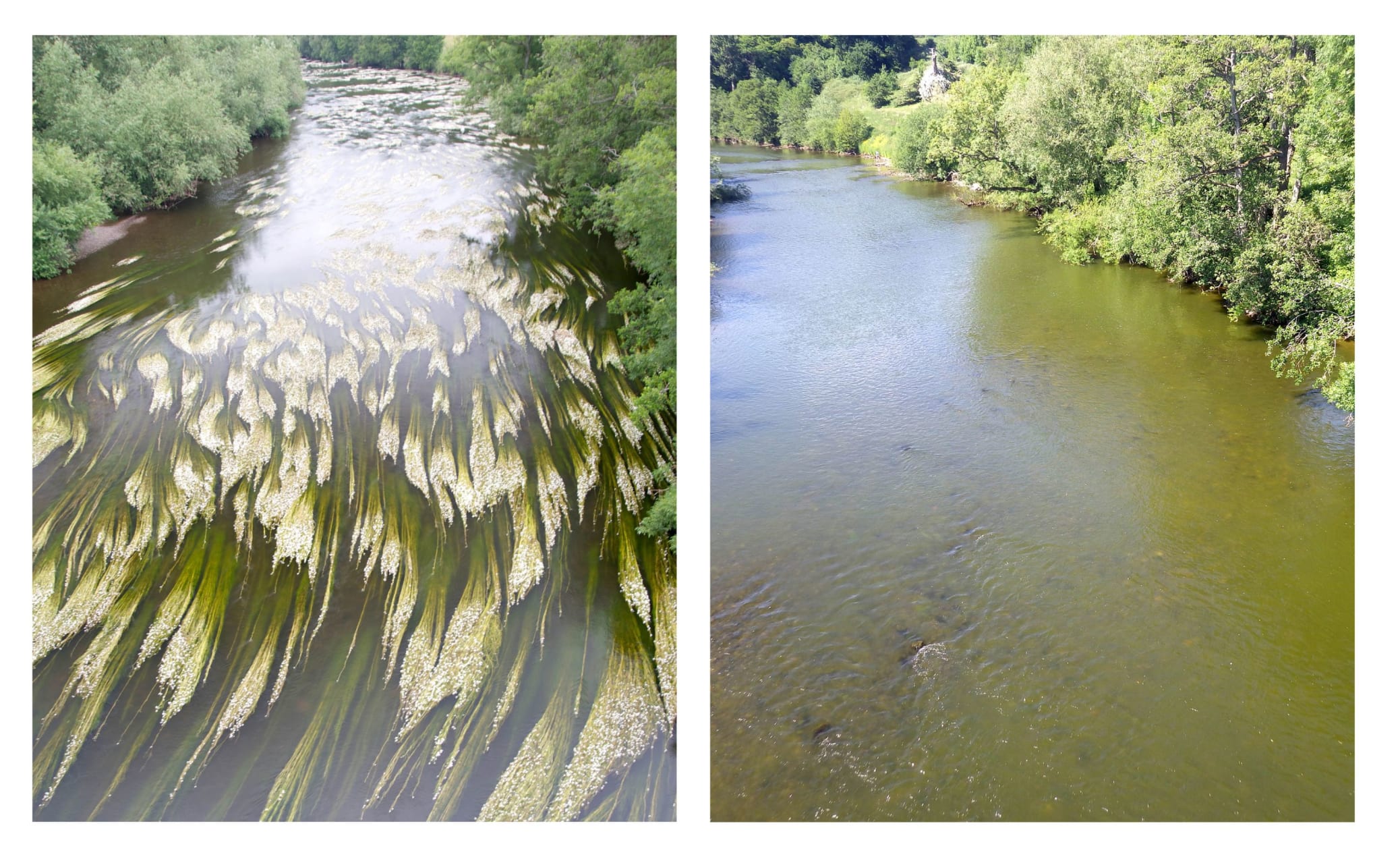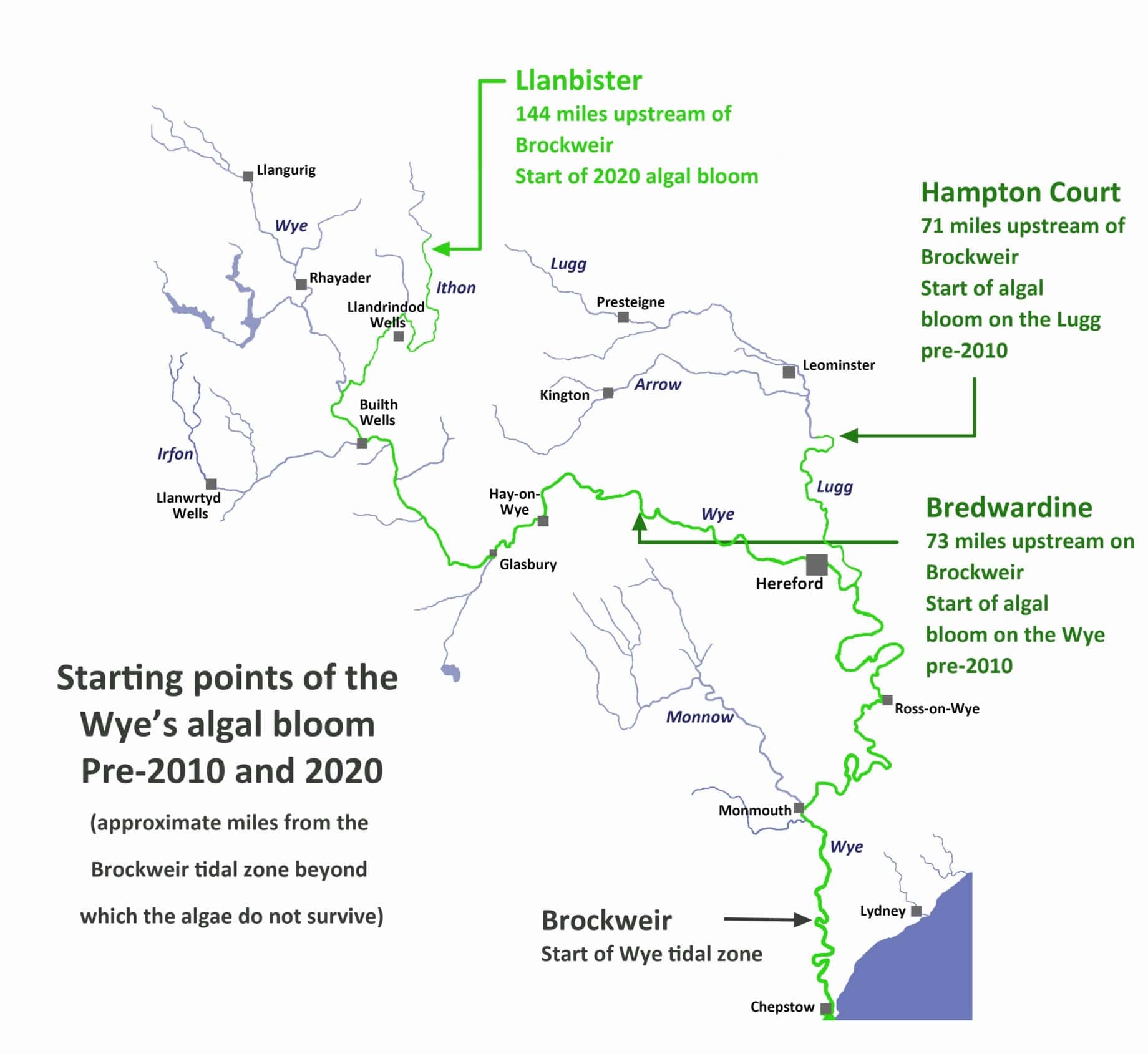Monday 8th June, 2020
There is considerable and understandable dismay that the normally clear waters of the Wye have once again turned a putrid green due to another severe algal bloom. The Usk has also suffered a bloom, albeit less severe, as have other rivers across Wales.
Those with long associations with the Wye will know that the river has always suffered mild algal blooms. However, their severity has increased significantly in the past three or four years.
They are also starting earlier in the year and lasting longer. While they used to be one-off events with the algae dying off or being flushed out with a rise in water levels, we are now experiencing multiple blooms throughout spring and summer. The river has a sickly appearance with its water resembling pea and at other times, French onion soup.
Permanent damage
This ailing look is no mirage. Thick algal blooms can have severe and permanent effects on the river’s ecology.
By discolouring the water, essential sunlight is prevented from reaching aquatic plants such as ranunculus, impeding their growth and even killing them off. These plants play a vital role in the river’s ecology, providing food and habitat for a range of invertebrate, fish and bird species. In addition, excessive algae reduces the availability of oxygen in the water at nighttime, which when combined with high temperatures, can kill fish such as Atlantic salmon, barbel and brown trout.
The damage isn’t just ecological. Countless tourism-related businesses and jobs up and down the Wye Valley rely on a clean, healthy river. Severe and prolonged algal blooms during the height of the visitor season will do nothing to help the area’s economy recover from the COVID-19 crisis.
Left: The Wye at Bridge Sollers, a few miles upstream of Hereford, in July 2013 showing clear water and extensive beds of ranunculus.
Right: Early June this year. The photo clearly shows the algal bloom and, although earlier in the year, a significant reduction in ranunculus.
The cause?
Algal blooms are caused by a combination of factors, including levels of light and flow. However, a large increase in the amount of phosphate, which acts as a fertilizer, entering the Wye’s headwaters is thought to be the principal reason for the recent increase in the blooms’ severity.
According to the latest modelling, the proportion of the phosphate in the lower Wye coming from agriculture has doubled in the past six years. The river is now failing its permitted levels of phosphate under the EU Habitats Directive.
The geographical location of this extra phosphate is also believed to be a factor in the blooms’ severity. The upper river in Wales is now a significant source following a large expansion of the poultry industry over the last decade. Since 2008 the upper catchment now hosts an extra ten million chickens with the Ithon (one of the river’s tributaries in Powys) having the lion’s share. This number of chickens produces large amounts of highly reactive phosphates from their manures, which find their way into the rivers.
Fueled by this phosphate, the algae moves downstream and, given the right conditions, divides every 24-48 hours. The further upstream the bloom starts the thicker it is at the bottom of the river.
Before 2010, the Wye’s algal bloom used to start becoming noticeable around the confluence with the Lugg (although the first signs were usually a few miles further upstream at Bredwardine). This year’s bloom was noticeable at Llanbister on the Ithon, around 90 miles upstream of the Wye/Lugg confluence.
How has this been allowed to happen?
Both Powys County Council and Natural Resources Wales have a legal responsibility to protect Special Areas of Conservation (SACs) such as the Wye. They have, however, been apparently unwilling to use the existing laws to protect the river from the nation’s desire to eat more free range eggs. In the case of Powys County Council, this includes considering the impact of new poultry developments individually and cumulatively. Evidently, this is something that is not happening.
The result is a river turning a putrid green every summer and having its ecology destroyed.
Most of the farmers the Foundation has worked with in Powys want to operate in an environmentally considerate way
Despite Welsh Government’s outward desire for sustainability and the protection of Future Generations, not to mention their legal obligations, there is little appetite to curb the planning excesses and environmental damage arising. In 2018 a formal complaint to the European Commission about the lack of regulation in Wales, inappropriate planning and lack of Water Protection Zones was lodged by Afonydd Cymru, the umbrella organisation for rivers trusts in Wales.
It is worth noting that the farmers we have worked with in Powys want to farm in an environmentally considerate way. They too have been let down by the Council’s planners who they assume are approving their applications having made the right environmental assessments.
What can we do?
Three of the four factors generating algal blooms are to do with climate. While we leave that for Presidents Trump and Xi Jinping to deal with, there are measures we can take to at least halt the increase in phosphate entering the rivers.
The Foundation has been working with Herefordshire farmers with some success to reduce the amount of sediment and accompanying phosphate washing into the rivers there. There is still work to do in that part of the catchment but we will need to expand our operation much more in Wales too.
We are already working with farmers, Noble Foods and Tesco to reduce the impact any of their suppliers are having on the river but this will not be enough on its own to prevent future blooms in the Wye. For that to happen, we are reliant on Powys County Council and Natural Resources Wales doing their job properly. The latter can only offer a view to the Council during the planning process and therefore cannot themselves stop the continued expansion of the poultry industry in Powys via that means.
However, they do issue the Habitat Regulations Assessment (HRA) that Powys Couny Council operate under in respect to all the SACs in their area. If the Council’s actions are in breach of the ‘Precautionary Principle’ that is enshrined in the Habitats Directive, the advice of the chief planner and within Natural Resources Wales itself, then this questions whether the HRA for their Local Development Plan is still valid. In Herefordshire, Natural England have enforced a moratorium on planning due to the Wye’s elevated phosphate levels, over-riding Herefordshire Council’s HRA.
You can help too. We would urge anyone who cares about rivers and who lives in Powys (or elsewhere in Wales) to write to their Member of Parliament and Assembly Member regarding of the disgraceful state of what was once the nation’s favourite river.
Right now, the Wye and other rivers across Wales need as much public support as they can muster.


